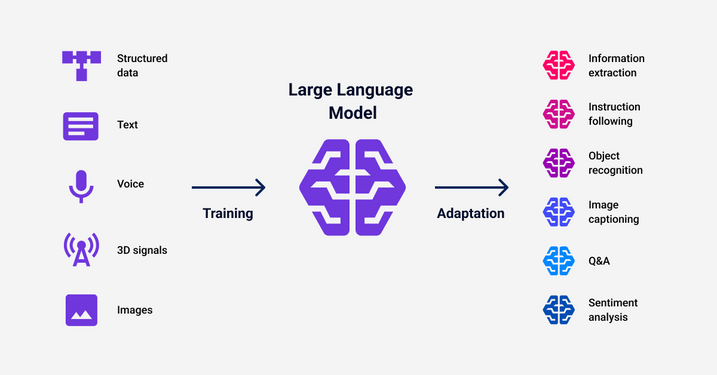Artificial Intelligence
What is a Large Language Model?
Learn how Large Language Models (LLMs) work: From the Transformer architecture to training on massive datasets, and their applications in customer service, content creation, and more.

The idea that machines can not only understand human language but also replicate it almost perfectly has become a reality. Large Language Models (LLMs) are powerful AI systems capable of analyzing, generating, and translating complex texts, transforming how we interact with technology.
But what makes these models so exceptional, and what role do they play in digital transformation?
What are Large Language Models?
Large Language Models (LLMs) are artificial intelligence systems trained on vast datasets to understand, process, and generate human language. They rely on neural networks, particularly Transformer architectures, first introduced in a groundbreaking 2017 paper. Examples of such models include OpenAI’s GPT series (like GPT-4) and Google’s BERT.

LLM simplified.
How do LLMs work?
The functionality of LLMs relies on processing text data to recognize patterns, grammar, meanings, and contexts. During training, the model analyzes enormous volumes of text, learning the likelihood of word sequences and developing a deep understanding of language. These models use billions or even trillions of parameters, optimized to deliver accurate predictions or responses.
How Large Language Models (LLMs) Work in Detail
The operation of Large Language Models is rooted in advanced AI techniques, particularly deep learning. These models learn to identify patterns and meanings in vast amounts of text data and use this knowledge to understand, predict, and generate language.
Here’s a closer look at how these complex systems work:

Simplified illustration of how LLMs work.
The Foundation: Neural Networks
LLMs use artificial neural networks composed of multiple layers of “neurons.” These neurons are mathematical functions that transform inputs (e.g., words or sentences) into outputs (e.g., predictions or responses). Each network layer extracts different levels of information:
- Early layers: Recognize basic features like word meanings or grammatical structures.
- Later layers: Capture abstract relationships, such as the context of a sentence or the sentiment of a text.
Transformer Architecture: The Key to Success
Most modern LLMs, such as GPT and BERT, are built on the Transformer architecture introduced in 2017. Transformers utilize two essential mechanisms:
- Self-Attention: This enables the model to determine which parts of a text are most relevant to the context. For instance, a Transformer can identify that the pronoun “she” refers to a previously mentioned person, even if several words separate them.
- Positional Encoding: To understand the order of words in a sentence, each word is assigned positional information.
Training: Learning from Massive Datasets
LLMs are trained on extensive datasets sourced from books, websites, academic papers, and other text corpora. The training process involves the following steps:
- Tokenization: Texts are broken into smaller units, called tokens (e.g., words, word fragments, or characters), which serve as the model’s input.
- Probability Prediction: The model learns to predict the likelihood of the next token in a sequence. For example, in the sentence “The cat sits on the,” the model calculates how likely “tree” or “chair” is to follow.
- Optimization: Model parameters are adjusted to minimize prediction errors through an iterative process called gradient descent.
Fine-Tuning
After general training, an LLM can be specialized for specific tasks, such as medical diagnosis or legal text analysis. Fine-tuning involves additional training on targeted datasets, enhancing the model’s accuracy for a particular domain.
Generation and Inference
When a trained model is used, it analyzes the input text, recognizes patterns, and generates responses based on its learned knowledge. It accounts for the context to produce coherent, often surprisingly human-like outputs.

Simplified illustration of how LLMs work.
Applications of LLMs
LLMs are used across various fields:
- Content Creation: Writing articles, reports, or creative content.
- Translation: Providing highly accurate translations between languages.
- Chatbots: Acting as virtual assistants in customer service, education, or entertainment.
- Data Analysis: Summarizing and analyzing large volumes of text data.
Practical Uses of LLMs
The potential applications of LLMs span multiple industries:
- Business and Administration: Automating report generation, contract analysis, and customer inquiries.
- Healthcare: Assisting in medical text analysis, diagnosis, and research.
- Education: Personalizing and enhancing learning processes through virtual tutoring tools.
- Creative Industries: Generating stories, scripts, or marketing content, unlocking new possibilities for content production.
LLMs in Customer Service
Large Language Models have the potential to revolutionize customer service. Their ability to understand human language with precision and respond empathetically enables a new level of interaction between companies and customers. LLM-based chatbots and virtual assistants can operate 24/7, handling a wide range of inquiries—from simple product questions to more complex issues like troubleshooting or claims. These models can deliver personalized responses by recognizing the context of a conversation and adapting to users’ needs.
A key advantage of LLMs in customer service is scalability. Unlike traditional call centers limited by staffing, AI-driven systems can manage unlimited queries simultaneously, improving efficiency and reducing wait times. Additionally, modern models continuously learn from interactions, becoming increasingly tailored to a company’s specific requirements over time.
However, LLMs do not entirely replace human interaction. They excel at handling routine queries but struggle with complex or emotionally charged issues. For this reason, many companies adopt a hybrid approach, where LLM-based chatbots serve as the first point of contact and escalate to human agents when necessary. This ensures efficiency without compromising customer satisfaction. In the long term, LLMs could make customer service not only more efficient but also more personalized—an essential advantage in an era where exceptional customer experiences drive brand loyalty.


